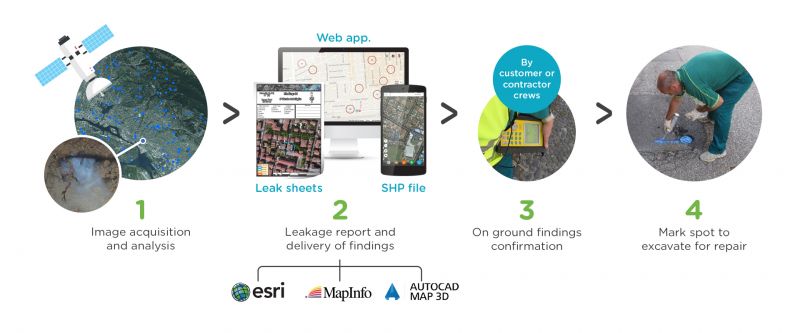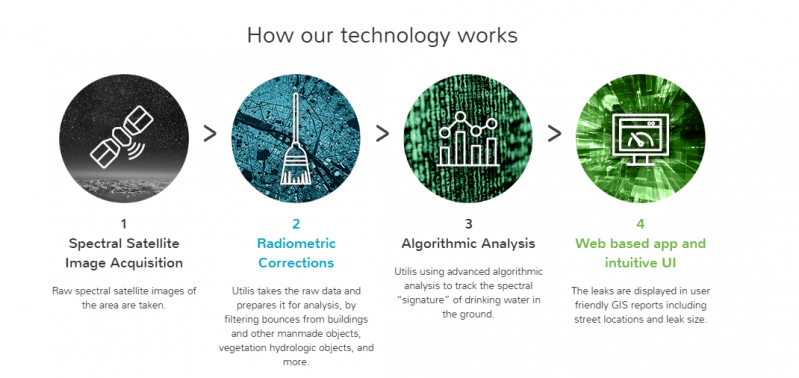In Conversation With: Lauren Guy, CTO & Co-Founder of Utilis Ltd.
Published on by Water Network Research, Official research team of The Water Network in Technology
The Water Network team had the pleasure to interview Lauren Guy, CTO & Co-Founder of Utilis Ltd.
Utilis Ltd. has developed a cost-effective software solution for detecting fresh-water leaks in urban water supply systems. It utilizes patented, one-of-its-kind remote-sensing technology.
By providing leakage locations with high accuracy, regardless of volume or demographic density, Utilis analytic technology helps municipalities, Water Utilities and contractors to reduce NRW (nonrevenue water) and improve efficiency in subterranean leaks detection/control.
 Q1: Thank you Lauren for taking the time to talk to us. It would be a pleasure to know more about you as a person before we start talking about UTILIS.
Q1: Thank you Lauren for taking the time to talk to us. It would be a pleasure to know more about you as a person before we start talking about UTILIS.
My name is Lauren Guy. 30 years old, married + 2. MSC in geophysics. My main passion is mainly the atmosphere and the things related to it – radiation transfers within the atmosphere, meteorology, remote sensing and such.
Q2: How did UTILIS came into existence? Was it inspired by your remote sensing background or your concern over the untracked water we are wasting?
It's a combination of both. I've done my master degree in Israel mainly focusing on radiation transfers within the atmosphere. Although it's not a direct connection to drinking water remote sensing – it laid the foundation of the knowledge about different interactions of radiation and different kinds of materials.
After I finished my masters and due to the fact that I always have been environmental oriented, I started working within a company focusing on 'creating' drinking water for usage (from groundwater, decal, pumping). There I discovered the catastrophic condition of non-revenue water and the old methods being used to deal with this problem. I decided to contribute my remote sensing knowledge to this cause and Utilis was formed.
Q3: UTILIS started back in 2014. Who else are the founding visionary members of the company?
When I decided about forming Utilis I partnered with a good friend, Mr. Eran Nevo, which has a lot of technical knowledge about programming and automation. Together we created the concept and automation of taking the algorithms that I wrote into a 'machine language'. Also, of course, there was a lot of support from the internal family, both emotionally and financially.
Q4: Leakage detection is a major problem Water Utilities are struggling with. There is software available for detecting leaks, but you introduced satellites for that purpose. Would you please explain how UTILIS helps in leakage detection?
 Before we came into the field, there were solutions to deal with NRW. From our perspective they are divided into two categories – meter by meter field verification by acoustic devices and high tech online/web based acoustic correlators and loggers.
Before we came into the field, there were solutions to deal with NRW. From our perspective they are divided into two categories – meter by meter field verification by acoustic devices and high tech online/web based acoustic correlators and loggers.
Although the first one is very accurate and can actually pinpoint a leak, it's very time-consuming and may take up to a year to survey an entire city.
If you survey a certain location, you most likely won't get back there for a year or two, if not more, and water may still leak without any way to know that. The second solution, of online acoustic devices comes to solve this problem, but they require a high capita expense at the beginning of the project and ongoing costs of the maintenance process.
Utilis is here to solve all of those problems. Because we can scan the entire system in one shot, and we can do it whenever the client wants – we can give an entire report of the system whenever necessary. More than that, we can give an estimate of the actual location of a leak within a buffer of only tens of meters.
Our solution does not require any prerequisites data or equipment, giving the client the option to receive his data right away in a matter of weeks.
Q5: How exactly does the entire process work? Right from collecting satellite images to giving results to the client?
Taken from satellite-mounted sensors – to spot leakage in underground distribution pipes. The raw imagery is then overlaid on GIS systems and is processed by Utilis' unique algorithms.
The Utilis algorithm detects drinking water, by looking for a particular spectral "signature" typical to drinking water. Eventually, the user is presented with a leakage graphic report overlaid on a map with streets, pipes and size information.

Q6: How frequently is the inspection of water infrastructure suggested in a year?
It depends on the needs of the client. Utilis can go from once every two weeks and up. Most of our clients require an image every month or every quarter.
Q7: How precise is the leakage detection by UTILIS? Can a small leakage such as 2 l/min be detected?
Utilis detect leaks from 0.5 l/m and up.
Q8: Can the satellites locate leakage in different terrain? How accurate are they in, for example, mountain terrain?
Yes. Utilis can operate in different kind of soil types and terrains. The great thing about Utilis is that we detect the leak at the fault location so even though the water might flow to a lower location on a mountainous terrain, we'll still see the origin.

Q9: Please explain the advantages of using UTILIS over the current methods?
As described in answer no. 4, the true ability to scan an entire system a few times per year is a great power that today is not accessible to 99.9% of the utilities out there.
Q10: Who are your current clients? What are the expansion plans for UTILIS in the future? Which market do you want to tab as a potential client?
Our current clients include water departments and utilities from around the world. Utilis expects that satellite leak detection will become a standard method to detect leaks. Our patented algorithm, GIS/analytic capabilities, and on-going research and development efforts will see many more improvements and capabilities over time.
In future, according to our R&D efforts, we hope to address departments and utilities that suffer from leakage of other liquids and materials.
Q11: Are you planning on expanding to any other applications in addition to the water sector?
Indeed. We are currently testing new methods for locating other types of liquids and materials that might leak out of pipes. It's currently in testing phases.
Q12: Would you like to say something to TWN members who work in Water Utility sector?
Embracing new technologies is always hard, but we truly believe that we are here to change the game. The thousands of leaks we discovered in the past year has an enormous environmental and economic value and we're more than happy to be here for that cause.
" The UTILIS Innovation Summit 2017 will be held in Tel Aviv, Israel between on 30 – February 2. We invite our customers, partners, service providers, water departments, utilities and prospects to participate in this event and network with key decision makers, market experts, and advocates of new technologies in the water industry."
Thank you for your time, Lauren!
Read More Interviews from the 'In Conversation With' Series
by The Water Network
Media
Taxonomy
- Technology
- Leakage Detection
- Data Management
- Leakage
- Infrastructure
- Leakage Reduction
- Urban Water Infrastructure
- Infrastructure Management
- Utilities
- Analysis
- Imaging Systems
- Data Management
- Satellite
- Data
3 Comments
-
Cool solution!. Take a look to the BRIGAID innovation project (www.brigaid.eu). We provide structural and ongoing support to innovators with solutions able to reduce the risks of floods, droughts and water scarcity periods, or extreme events (fires, heat waves, etc.)
-
very interesting
-
very interesting